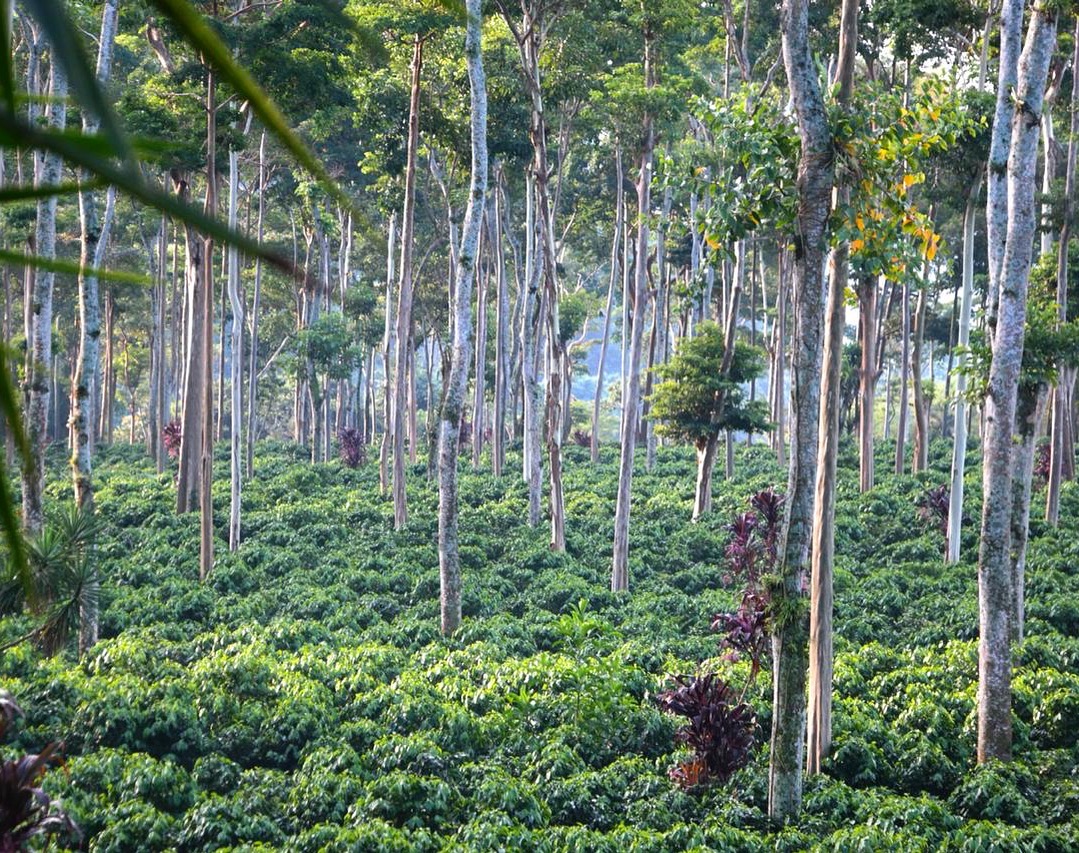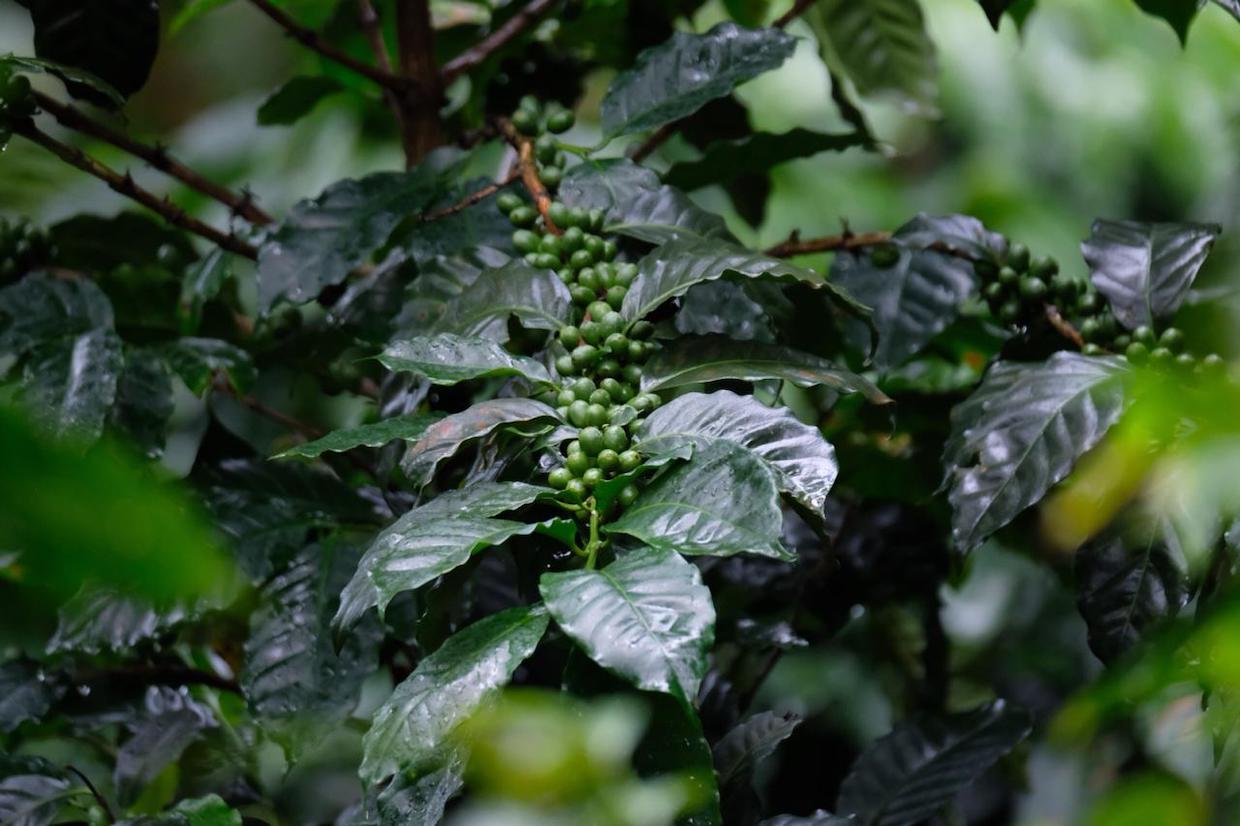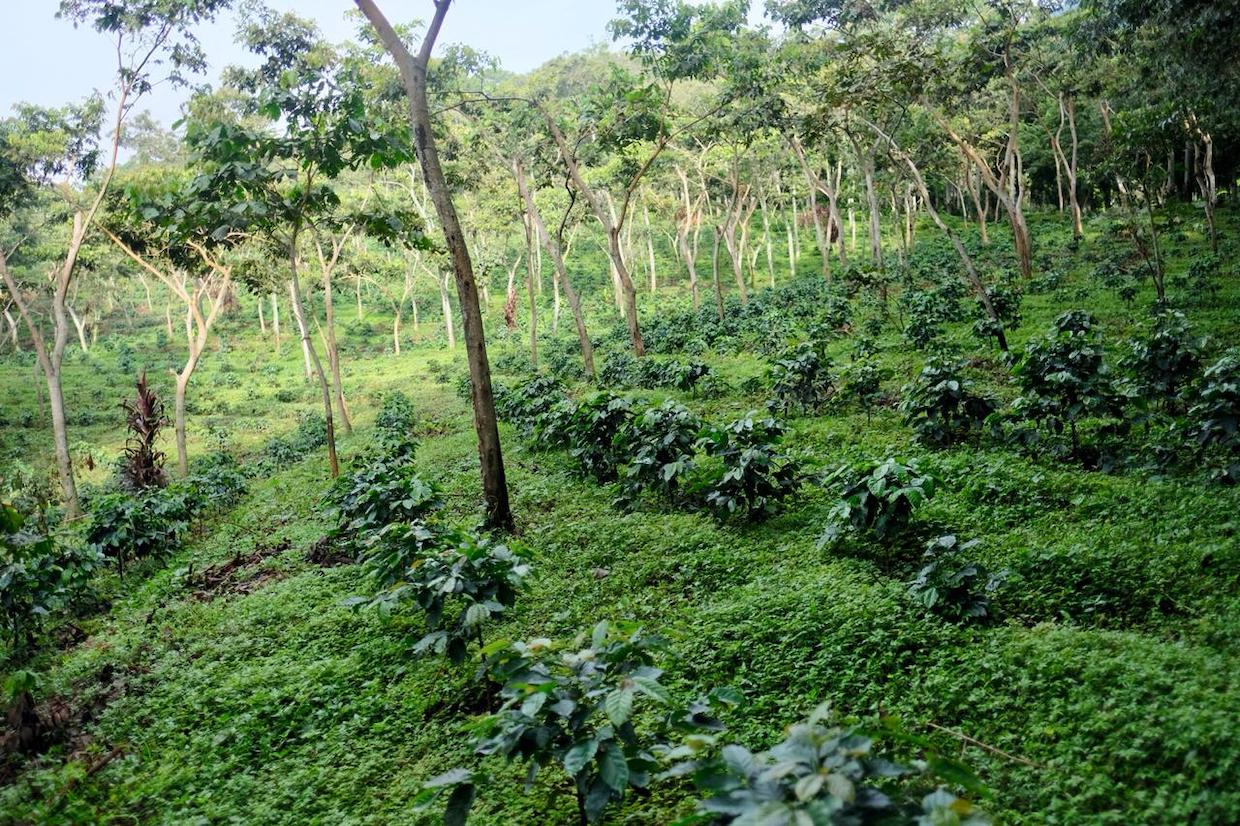
Coffee grown under a diversity of shade trees at Finca San Jeronimo in Guatemala. Photo courtesy of the author.
The cascading effects of the pandemic, supply chain pressures and Russia’s war in Ukraine have skyrocketed the price of nitrogen fertilizer, by some estimates as much as 300%, since 2020.
As a result, farmers of all types and sizes worldwide are taking a big hit — and few have been hit quite as hard as coffee farmers.
Coffee farmers operate on razor-thin margins, often selling coffee for less than the cost of production. As if that weren’t enough, many coffee farmers are also contending with a changing climate, pests and diseases that threaten their production output.
Unlike some other crops, coffee prices have not increased in step with surging fertilizer prices, leaving farmers in an even more precarious position.
Contemporary coffee farming often involves the annual application of synthetic fertilizers. Without these inputs, many farms lack the soil fertility to produce fruitful crops.
The average rate of nitrogen fertilizers used on coffee farms is comparable to hybrid corn, which is one of the crops with the highest nitrogen demand. Synthetic nitrogen fertilizers applied at these rates produce a plethora of negative effects, many of which compound over time.
Due to the coffee tree’s ecological niche, preferred climate conditions, and physiological traits, there is a clear path forward for the successful cultivation of healthy and abundant trees without the use of synthetic nitrogen.
Environmental Effects of Nitrogen Fertilization
When I envision a coffee farm, I see majestic views down the high-altitude rows of emerald green trees. I remember the sweet jasmine smell of a sea of flowering coffee trees, and I feel the enthusiastic buzz of all the work that transforms the fruit of this tree into magical drinks.
What our senses don’t capture is the role synthetic fertilizers are playing in this environment, where an increase in productivity can come at a high price, both financially and ecologically. The downstream effects of synthetic fertilizer use can ultimately bring farms to the brink of collapse.

Deep green leaves and full fruit set of a healthy, biologically farmed coffee tree. Photo courtesy of the author.
People might be surprised to learn just how much nitrogen fertilizer coffee farms are applying to their soils. What is even more surprising is that up to 64% of the nitrogen fertilizer applied to coffee fields is lost as a result of leaching and volatilization, and the plant takes up only about 25% of the nitrogen. The nitrogen that is leached through the soil profile makes its way into waterways and groundwater, polluting the drinking water of the very same farmers and their surrounding communities.
The volatilization of synthetic nitrogen fertilizers contributes nitrous oxide to the atmosphere. Nitrous oxide has an atmospheric warming potential more than 200 times greater than carbon dioxide. Meanwhile, due to our changing climate, the areas currently suitable for coffee production are estimated to decrease by more than 50% within the next 30 years. Who would have thought that standard soil fertility practices would be a contributing factor?
Soil Organic Matter and Drought Resiliency
One of the unique characteristics of coffee farming is the lack of irrigation infrastructure on most farms, outside of Brazil. Coffee trees rely on predictable rainfall cycles to produce a crop of cherries each year. An essential part of what makes this possible is the high organic matter in the typical coffee farm soil that serves as a sponge to hold and release water to plants as needed. Each 1% increase of soil organic matter can store 144,000 liters of water per hectare.
Between rain events and during the dry season, coffee trees can access the water stored in the soil through capillary action, the same way water moves up through a straw resting in a glass.
Synthetic nitrogen fertilizers were once thought to contribute to, or at the very least maintain, soil organic matter. However, several recent long-term studies show that these fertilizers caused a net decline in soil organic matter, even with massive additions of residues — i.e. organic matter — to the soil. The implication to soil health as a whole is extreme, and in coffee trees it represents a threat to climate and drought resiliency.
Soil Health and Plant Nutrition
Another notable characteristic of coffee is that it is one of the few crops for which compensation may be based on quality. Under optimal nutritional conditions, the secondary metabolites produced by coffee trees end up in the fruit and seed, thus determining the unique and robust flavor profiles that make each coffee special. The key to creating optimal nutritional conditions is assuring the availability of a broad spectrum of minerals for plant uptake, mediated by a thriving web of soil microorganisms.
The exorbitant rates of synthetic nitrogen used on coffee farms can impede the uptake of essential nutrients like calcium, potassium, boron, copper, and several other key mineral nutrients that have associations with coffee quality.
Unfortunately, this is not a one-season phenomenon. Seasonal applications of synthetic nitrogen acidify the soil, causing lasting soil nutrient imbalances and potentially toxic conditions. The chemistry within plants is also negatively affected. Elevated nitrogen levels in plant sap decrease the concentrations of phenolic compounds and other plant secondary metabolites responsible for creating each coffee’s unique flavor signature.
These same flavor-giving compounds are also responsible for imparting immune-boosting qualities to plants that help ward off diseases and pests. The most detrimental impact synthetic fertilizers have on soil is wiping out the beneficial microorganisms responsible for nutrient cycling, building soil structure and providing immune support to plants.
To the untrained eye, most coffee trees look vibrant and healthy due to the deep green leaves and luscious vegetative growth resulting from high nitrogen fertilizer rates. However, beneath the façade, many of these trees will have inconsistent fruit formation, sub-optimal flavor and poor immunity.
Yet just as coffee stands out as one of the most complex and challenging crops to grow, it also allows for myriad creative solutions. We just have to start from the ground up.
Biological Coffee Farming
Coffee as an agricultural commodity is unique in that it can grow alongside and in the shade of countless other tree species. This gives coffee farmers the potential to produce additional revenue streams through other crops and generate an abundance of fertility from within their farm gates.
In many coffee-growing regions in Central America, trees like Inga (Inga edulis) and Poro (Erythrina poeppigiana) spotted from a distance can indicate the presence of coffee trees beneath their shade. Inga and Poro are both members of the Fabaceae family and have the unique ability to convert atmospheric nitrogen into a biologically available form of nitrogen in the soil. This process is called biological nitrogen fixation.
Through this process, nitrogen-fixing trees on coffee farms can contribute 60-350 kilograms per hectare (kg/ha) of nitrogen from leaf litter and residues and another 30-60 kg/ha of N from fixation in the rhizosphere. This can exceed the recommended rates of synthetic nitrogen, which depending on the source tends not to exceed 300 hg/ha, yet in a more plant-available form that doesn’t leach or volatilize. This comes with the added benefit of significantly increased soil organic matter, enhanced nutrient cycling and water-storing capacity. To further propel this biological flywheel, farmers can add perennial nitrogen-fixing ground covers to their systems, adding to the above-listed benefits and offering soil erosion mitigation.

Young coffee trees growing with a nitrogen-fixing ground cover beneath the shade of Inga edulis. Photo courtesy of the author.
In order to fully benefit from the wonder of biological nitrogen fixation, farmers need to understand the interplay between soil minerals, the physical structure of the soil and beneficial soil microorganisms.
Nitrogen-fixing plants form nodules on their roots to host rhizobium, the nitrogen-fixing bacteria that perform the miraculous feat of converting inert atmospheric nitrogen into a plant-available form of nitrogen. When nitrogen fixation occurs in these root nodules, they will be pink to blood-red color inside. When active fixation isn’t taking place, the nodules will be a pale grayish color inside.
I have been on numerous farms in the tropics where the system’s fertility was predicated on nitrogen fixation only to discover inactive root nodules. The reason in almost all cases was a lack of available minerals — namely calcium, copper, cobalt, and iron — some of the same minerals affected by the overuse of nitrogen fertilizers. All save for iron are typically in low supply in tropical soils.
The first barrier to clear in optimizing nitrogen fixation is to ensure these four minerals are adequately supplied. By increasing soil organic matter and balancing the soil minerals, referred to as base cations, soils become filled with pore space. The pore space acts like a newly developed neighborhood made up of comfortable houses. Upon its construction, multitudes of beneficial microorganisms fill the new houses. They get right to work in the new community, cycling nutrients, defending the plants from disease and continuing to build and enrich the soil.
The exact process for optimizing nitrogen fixation and overall soil nutrient cycling looks different on each farm. Often this will require other inputs like biostimulants, compost, microbial inoculants, organic fertilizers and mineral amendments to kickstart the system. It’s not a recipe but a set of principles based on plant physiology, mineral nutrition, and soil ecology.
Finca San Jeronimo Miramar (FSJM), a picturesque coffee farm in Guatemala, is a prime example of the transition from synthetic fertilizer and pesticide dependence to a fully biological method of producing world-class coffee.
They have seamlessly integrated a principle-based approach to fit the farm’s operational capacity. The results speak for themselves. At FSJM, coffee leaf rust infections historically hovered around 20-40%, even while using several chemical fungicides. After four years of no chemical fungicide applications, enhanced plant nutrition, and improved soil microbiome, the farm has reported that rust infection rates are now less than 5%.
Over the same four-year period, synthetic fertilizers were eliminated completely. Yet, the coffee trees display luxurious growth, even during physiologically taxing periods like flowering and fruit fill. Most importantly, yields and fruit quality continue to rise, and the surrounding ecosystem is thriving.
The untenable cost of synthetic fertilizers combined with declining health and productivity of many coffee farms should make a strong case for the need to embrace healthy soils.
Fortunately, coffee trees have a preternatural ability to grow remarkably well and produce abundant and high-quality yields without the presence of synthetic nitrogen fertilizers — a fact that should provide hope for the future of coffee.
[Editor’s note: Daily Coffee News does not publish paid content or sponsored content of any kind. Any views or opinions expressed in this piece are those of the author and are not necessarily shared by Daily Coffee News or its management. Do you have a story idea for DCN? Share it here.]
Sam Knowlton
Sam Knowlton is an agronomist and founder of SoilSymbiotics. He consults worldwide with farms and leading agrifood companies. Sam specializes in designing regenerative coffee farming systems. Learn more and connect here: www.samknowlton.co
Comment
1 Comment
Comments are closed.






Beautiful pictures and article.